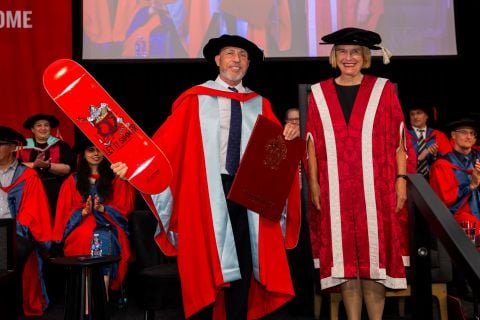Not only did the researchers detect that mum Nakuru was pregnant through changes in her hormones, but they accurately predicted the calf’s arrival to within a day, helping zookeepers and vets prepare for the impending birth.
A team of reproductive experts led by Dr Kerry Fanson has been working with the Zoos Victoria keeper and vet teams since 2022 to monitor female giraffes and understand their reproductive status by extracting hormones from faecal samples.
In May last year, the team from the Wildlife Conservation and Reproductive Endocrinology Lab in the School of Agriculture, Biomedicine and Environment, detected an increase in progesterone – a key pregnancy hormone – for 13-year-old Nakuru, indicating she was pregnant.
Dr Fanson said they were delighted to be able to detect Nakuru’s pregnancy using remote, non-invasive monitoring, which ensured minimal disruption during this important time.
As the due date approached, focus then turned to how they could further support Nakuru and the zookeepers by detecting when birth was imminent.
“We continued to monitor her progesterone levels to make sure everything was progressing well, however one thing that progesterone can’t tell us is when birth will occur,” Dr Fanson said.
Being able to anticipate the timing of birth is incredibly valuable for animal care teams, helping ensure the best possible support for both mother and calf. For giraffes, whose size and physiology make birthing more complex, this information is especially important.
Historically, it has been difficult to predict when birth will occur in giraffes. However, using data from another giraffe pregnancy, Dr Fanson’s team was able to identify a novel biomarker for predicting birth.
“We found that a metabolite of cortisol shows distinct changes in the three weeks leading up to birth. Although cortisol is often thought of as a stress hormone, it also plays a really important role in the birthing process. Because we only had data from one previous pregnancy, we weren’t sure how accurate our prediction would be. We were thrilled that it worked so well,” Dr Fanson said.
Remarkably, the team succeeded in predicting the timing of Nakuru’s birth.
Laura Weiner, Life Sciences Manager Carnivores and Ungulates Melbourne Zoo, said: “Being able to monitor Nakuru's pregnancy during her 15-month long gestation has been essential to our welfare toolkit.
“In the end, Dr Fanson's Lab was able to accurately predict her birth window down to 24 hours.
“Our entire team were so excited to receive that final prediction. It helped us plan for the new arrival, who was our first giraffe calf in 19 years.”
The little boy was born on August 1 and has been entertaining crowds at Melbourne Zoo since his first public outing.
A public vote has been held to name him, with the result to be announced soon.
Media contact
media@latrobe.edu.au



